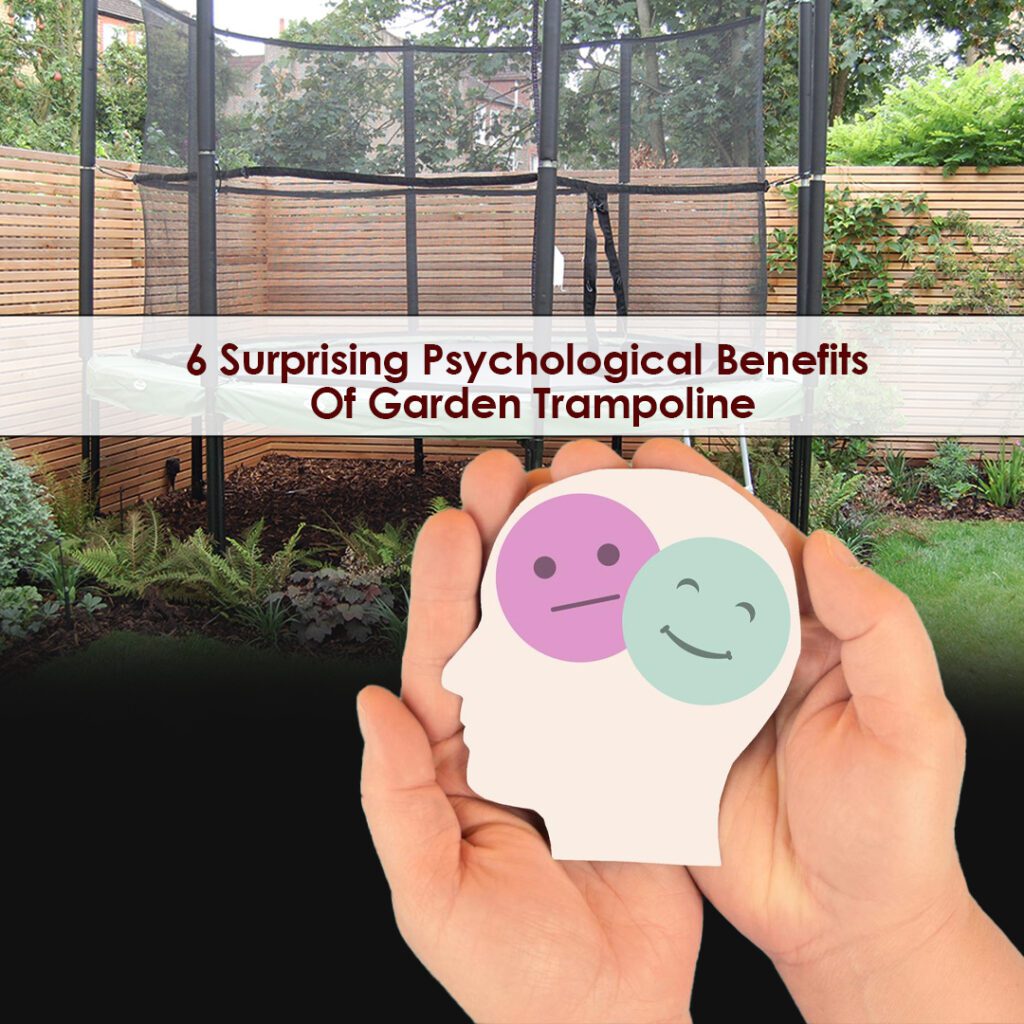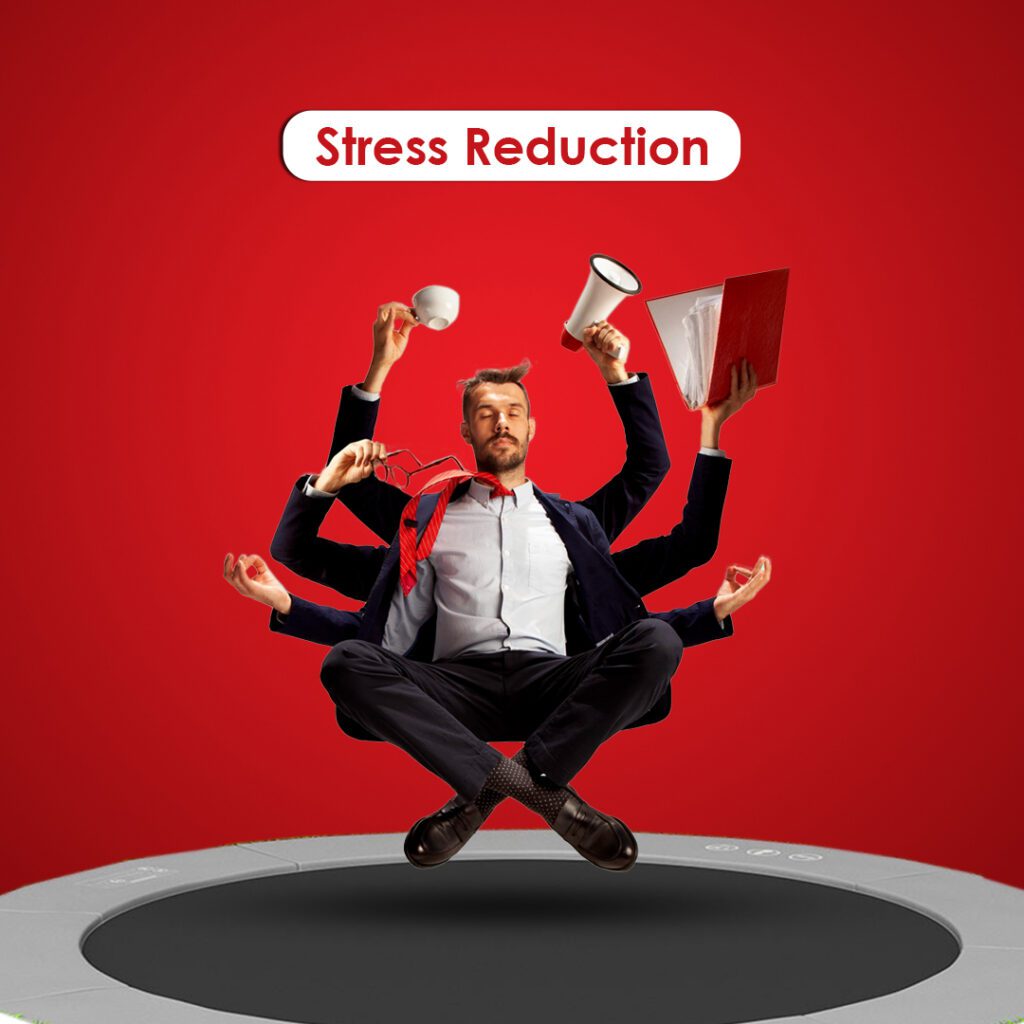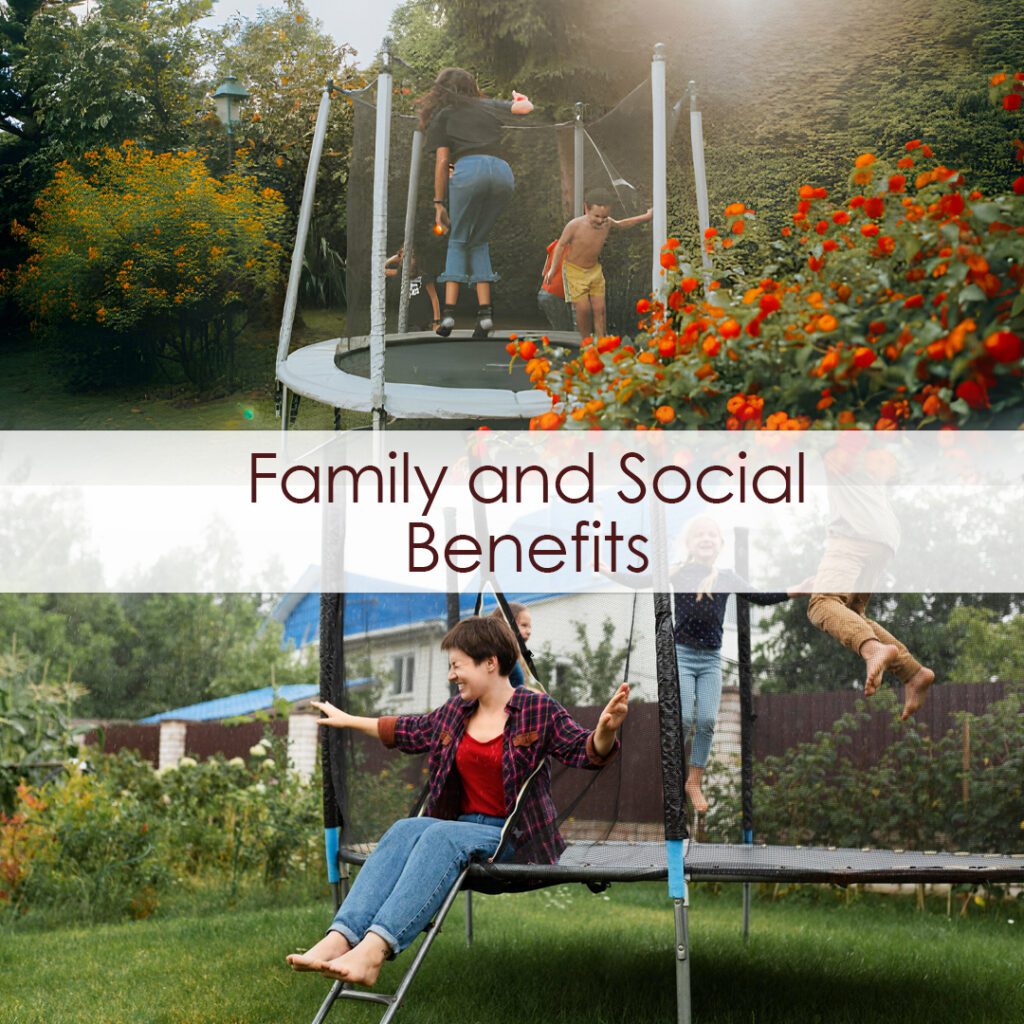
Trampoline is the new trend in the UK, and people are trying it out for themselves. Trampolining is a fun way to spend time and enjoy. People use trampolines for various benefits, from health benefits to recreational purposes. But, did you know it has some serious psychological benefits too?
Table of Contents
ToggleIf you’ve been feeling stressed or anxious recently, jumping on a trampoline can help clear your mind and shift your mood. The bouncing motion is meditative and helps calm worried thoughts.

In this blog, we’ll talk about six surprising psychological benefits that come with having a garden trampoline. Get ready to discover aspects you might not know about but could find quite fascinating!
1. Stress Reduction:

Bouncing on a trampoline can help reduce stress and anxiety in surprising ways.
Release Tension
As you jump on a trampoline, it releases muscular tension and pent-up energy in your body. As you bounce, your muscles contract and relax in a rhythmic pattern, which helps loosen tight areas like your neck, back, and legs. This can improve circulation and flexibility while releasing hormones that act as natural painkillers and mood boosters.
Elevated Mood
Have you ever felt sad or frustrated and gone for a walk or jog and felt better afterwards? Bouncing on a large 14ft trampoline, apart from giving you a large space to jump it will act as natural antidepressants and make you feel good. This can help alleviate symptoms of anxiety and depression and promote an overall sense of well-being and happiness.

Clear Your Mind
As you concentrate on jumping and balancing, your mind shifts away from your everyday worries and anxieties. This can help you gain a new perspective and a renewed sense of calm. Bouncing is almost meditative in its ability to quiet a restless mind.
2. Improved Sleep Quality:

Trampolining for just 30 minutes, 3 times a week, can significantly improve your sleep quality and duration.
Many people find that trampolining in the evening helps establish a consistent sleep-wake cycle. The burst of activity at the same time each day cues your body to expect sleep a few hours later. This can be especially helpful if you have an irregular work schedule or struggle with insomnia.
In addition to the chemical and physical benefits, trampolining can reduce anxiety and clear your mind of any nagging thoughts that keep you up at night. By the time you step off your garden trampoline, you’ll likely feel more centred and calm.
3. Adrenaline Rush:

Jumping and performing tricks on a trampoline releases adrenaline, the “fight or flight” hormone, which can positively impact your mood and energy levels.
As you bounce higher and higher, your adrenaline surges. This rush makes you feel excited and joyful. Studies show that adrenaline activates the reward centre in your brain, releasing dopamine that makes you feel good and want to keep bouncing.
Adrenaline also provides an energy boost. After jumping for just a few minutes, you’ll feel more awake and alert. This can help combat fatigue and make you feel more productive.
Trampolining is a great way to get your thrill-seeking fix in a controlled way. The rush experienced while jumping at heights in a relatively safe environment can satisfy your need for excitement and adventure, but you should be following the safety tips as well. This “adrenaline addiction” or “sensation seeking” leads to the desire to replicate that feeling of euphoria again and again.
For children and teens, in particular, trampolining helps constructively channel excess energy and restlessness through the adrenaline spike—the excitement of learning new tricks and skills. At the same time, bouncing builds confidence through a sense of accomplishment.
4. Endorphin and Dopamine Release:

Endorphins are hormones produced naturally in the body that act as natural painkillers and mood boosters. Trampolining triggers the release of endorphins, which can elevate your mood and reduce stress.
- Endorphins interact with the receptors in your brain that reduce the perception of pain. This results in an improved mood and sense of well-being.
- The impact of increased endorphins from exercise like trampolining can last for several hours after jumping. This gives you prolonged benefits of feeling good and less stressed.
- Endorphins also act as natural antidepressants. They help alleviate symptoms of mild depression and anxiety and improve self-esteem.
Dopamine
Jumping on a trampoline leads to the release of dopamine in your brain, the chemical messenger responsible for feelings of pleasure and reward. Dopamine gives you a natural high and boosts your mood.
Improved Mood
As you jump, dopamine is released in your brain, activating your body’s reward system and elevating your mood. The thrill of jumping up and down, doing somersaults and other aerial tricks triggers dopamine release, making you feel good. Make sure you wear trampoline socks made for safety while doing all the tricks. Trampolining can give you an almost euphoric rush as you experience the sheer joy of movement.

Stress Relief
In addition to improving your mood, dopamine helps relieve stress and anxiety. The repetitive motion of bouncing, combined with the dopamine hit, helps calm your mind and body, melting away tension and worry. Jumping on a trampoline provides an outlet for pent-up energy and frustration, leaving you feeling more relaxed and serene.
Enhanced Cognition
Dopamine is essential for motivation, reward-seeking behaviour, and motor control. By stimulating dopamine release, trampolining enhances your cognitive abilities, such as problem-solving skills, memory, attention span and concentration. The increased blood flow to your brain delivers more oxygen, supporting optimal brain function.
5. Family and Social Benefits:

A garden trampoline can bring families and friends together in fun, memorable ways. Whether it’s children bouncing with neighbourhood pals after school or family barbecues where people of all ages join in, a trampoline creates an inviting social space for bonding.
Bringing Families Closer
There’s something about the shared experience of bouncing, trying new tricks, and laughing together that brings families closer. Parents and children can rediscover their playful sides as they enjoy an activity together. Siblings build memories of trying to outdo each other with impressive bounces and flips. Trampoline parties can be arranged in this case. They give families an opportunity to strengthen connections through play.
Fostering New Friendships
Trampolines attract children and bring them together, helping them forge new friendships. Children bond over learning new skills from each other, like front flips, seat drops or high bounces. Garden trampolines often become a social hub in neighbourhoods, as children from come over to bounce. These shared experiences create lasting memories and inside jokes that form the foundation for new friendships.
6. Enhanced Cognitive Function:

Trampolining provides significant benefits for your brain and mental well-being. Regular exercise, like bouncing on a trampoline, has been shown to promote the growth of new neural connections in the brain that enhance cognitive functions.
Improved memory
Exercise increases the size of the hippocampus, the part of the brain responsible for memory. This can help boost your ability to retain and recall information. Studies show regular cardio exercise like trampolining can lead to measurable improvements in memory.
Better focus and concentration
When you bounce on a trampoline, your heart rate increases, pumping more oxygen-rich blood to your brain. This enhances your brain’s ability to focus and pay attention. Many people report improved concentration and mental clarity after exercising.
Reduced risk of cognitive decline
Exercise lowers the risk of age-related mental decline and neurodegenerative diseases like dementia and Alzheimer’s. Staying physically and mentally active with hobbies such as trampolining as you get older can help maintain brain health and independence.
Conclusion
So there you have it, having a garden trampoline in your garden is not just for children – it’s a happiness booster for everyone. Jumping on it for only 30 minutes a few times a week can really lift your mood. Bouncing around, feeling like a child again, releases happy hormones called endorphins.
Apart from being fun, trampolining is good exercise that helps ease stress and anxiety. It even improves how well you sleep. The up-and-down bouncing tires your body, making it easier to get a good night’s sleep. Plus, it calms your mind and stops those restless thoughts.
So, if you have a trampoline in your garden, don’t wait – bounce on it and feel the simple joys that make life better for everyone!
FAQ's
Can trampolines help with anxiety?
Yes, trampolines can aid in reducing anxiety. Bouncing promotes the release of endorphins, which contribute to stress relief and improved mood.
Does trampoline help with depression?
Trampolining can have positive effects on depression. The physical activity stimulates the release of neurotransmitters, fostering a sense of well-being and alleviating symptoms.
What are the benefits of trampoline therapy?
Trampoline therapy provides sensory stimulation, improves coordination, and enhances motor skills. It can also boost mood, making it beneficial for individuals with sensory processing issues or developmental challenges.
What effects does trampoline have on the brain?
Trampolining stimulates the brain by promoting neuroplasticity. The coordination and balance required during bouncing contribute to cognitive development and can have positive effects on memory and concentration.
Are trampolines good for mental health?
Yes, trampolines are beneficial for mental health. Regular bouncing promotes the release of endorphins, reduces stress, and improves overall mood, contributing to positive mental well-being.


